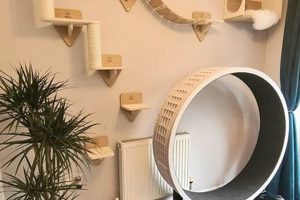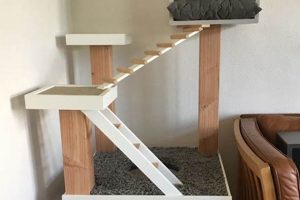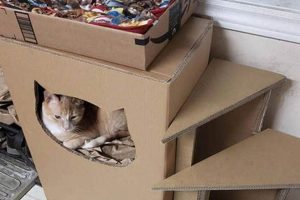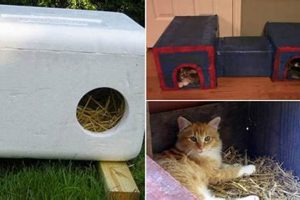A self-constructed shelter designed to protect felines from the elements when outside is a practical solution for pet owners. These customized structures provide refuge from inclement weather such as rain, snow, and extreme temperatures. An example includes a simple, insulated box constructed from readily available materials like plywood and recycled blankets.
Providing a secure outdoor sanctuary for cats offers several advantages. It promotes the animal’s well-being by reducing the risk of hypothermia or heatstroke. Furthermore, it can deter the cat from seeking shelter in potentially dangerous locations such as under car hoods or in sheds containing hazardous materials. The concept of providing dedicated outdoor shelters for animals has historical roots in agricultural societies, evolving into modern forms of pet care and responsibility.
The following sections will delve into the specific materials, construction techniques, and design considerations pertinent to creating weather-resistant and comfortable habitats for feline companions. The focus will be on practical application and cost-effective solutions applicable to various skill levels and environments.
Practical Considerations for Constructing a Feline Outdoor Shelter
The subsequent guidelines offer insight into optimizing the construction of durable and effective outdoor shelters for cats. Attention to these details will enhance the comfort and safety provided to the animal.
Tip 1: Material Selection: Prioritize weather-resistant materials such as treated lumber or durable plastic for the structure’s exterior. These choices mitigate water damage and prolong the shelter’s lifespan. Example: Cedar wood possesses natural insect-repellent properties, making it a suitable option.
Tip 2: Insulation Implementation: Integrate insulation materials, such as rigid foam or straw, within the shelter walls and floor. This crucial step regulates temperature and offers protection against extreme cold or heat. Example: Reflective bubble wrap can be utilized to minimize heat absorption during summer months.
Tip 3: Entrance Design: Keep the entrance small to retain heat during colder months and minimize the entry of rain or snow. An overhanging roof or awning can further protect the entryway. Example: A 6-inch by 6-inch opening is generally sufficient for an average-sized cat.
Tip 4: Moisture Control: Ensure adequate drainage within the shelter to prevent moisture accumulation. Incorporate small drainage holes in the floor if necessary. Example: A slightly sloped floor can facilitate water runoff.
Tip 5: Elevated Platform: Construct the shelter on a slightly elevated platform or base to prevent ground moisture from seeping into the structure. This also offers some protection against flooding. Example: Concrete blocks or pressure-treated wood can serve as a stable and moisture-resistant base.
Tip 6: Location Selection: Position the shelter in a sheltered location, away from strong winds and direct sunlight during the hottest part of the day. Placing it against a building wall or under an overhang offers added protection. Example: A south-facing location will receive maximum sunlight during winter, aiding in warmth.
Tip 7: Roof Construction: Construct a slightly sloped roof that effectively drains water away from the entrance. Roofing materials such as asphalt shingles or durable plastic sheeting can enhance weather resistance. Example: Overlapping shingles create a watertight barrier.
Adhering to these guidelines will result in a secure and comfortable outdoor shelter, promoting the well-being of feline companions. The careful selection of materials, attention to insulation, and proper placement are critical factors in creating a sustainable and effective haven.
The following sections will cover specific construction plans and design variations to further personalize the outdoor shelter for individual cat needs and environmental considerations.
1. Weather Resistance
Weather resistance is a fundamental consideration in the design and construction of any exterior feline shelter. The structure’s ability to withstand environmental elements directly affects its utility in protecting the animal from adverse conditions. Compromised weather resistance can lead to structural damage, reduced thermal insulation, and potential harm to the occupant.
- Material Selection for Exterior Surfaces
The choice of materials for the outer layers of the shelter directly impacts its ability to repel water and withstand prolonged exposure to sunlight. Materials such as treated lumber, durable plastics, and metal sheeting are commonly employed due to their inherent resistance to moisture and degradation. Untreated materials are susceptible to rot, warping, and eventual structural failure, rendering the shelter ineffective. Example: Using pressure-treated plywood instead of standard plywood significantly extends the shelter’s lifespan in wet climates.
- Roofing Design and Implementation
The roof serves as the primary barrier against precipitation, necessitating a design that effectively channels water away from the structure and prevents leaks. A sloped roof is a common feature, facilitating water runoff. Roofing materials such as asphalt shingles, metal roofing, or waterproof membranes are used to create a watertight seal. Insufficient roof design or compromised materials can result in water infiltration, leading to mold growth, insulation damage, and discomfort for the cat. Example: Overlapping asphalt shingles, properly installed, provide a reliable waterproof barrier.
- Sealing and Joint Protection
The seams and joints of the shelter are potential points of entry for water and wind. Proper sealing and weatherproofing of these areas are crucial for maintaining the structure’s integrity. Caulking, weather stripping, and sealant applications are used to create airtight and watertight seals. Inadequate joint protection can lead to drafts, moisture accumulation, and accelerated deterioration of the structure. Example: Applying exterior-grade caulk to all seams and joints after assembly minimizes water penetration.
- Drainage Systems and Moisture Control
Even with robust weatherproofing measures, moisture can still accumulate inside the shelter due to condensation or accidental exposure. Implementing drainage systems and moisture control strategies is essential for preventing mold growth and maintaining a dry, comfortable environment. Drainage holes in the floor, ventilation openings, and the use of moisture-wicking materials can help to mitigate moisture-related problems. Lack of drainage can result in a damp environment, increasing the risk of respiratory issues for the cat. Example: Drilling small drainage holes in the shelter’s floor allows excess water to escape.
The integration of weather-resistant features into the design and construction directly affects its long-term efficacy. Addressing each of these aspects ensures that the shelter will provide effective protection for the animal, regardless of the prevailing weather conditions, ensuring longevity and resilience to environmental stressors.
2. Thermal Insulation
Thermal insulation is a critical component of a self-constructed outdoor cat shelter, directly influencing the animal’s ability to maintain a stable body temperature in varying environmental conditions. Inadequate insulation results in the rapid loss of heat during cold weather and excessive heat gain during warm weather, potentially leading to hypothermia or hyperthermia, respectively. The strategic integration of insulating materials mitigates these temperature fluctuations, creating a more stable and habitable environment for the feline occupant. Example: A shelter lacking insulation may experience internal temperatures mirroring the external environment, rendering it unsuitable for sustained occupation during extreme weather.
The selection and implementation of thermal insulation materials require careful consideration of several factors. These include the material’s R-value (a measure of thermal resistance), moisture resistance, and safety for animal contact. Common insulation materials include rigid foam boards, fiberglass batts, and natural materials such as straw or recycled denim. Rigid foam offers high R-value and moisture resistance, making it a practical choice for many climates. Fiberglass batts provide effective insulation but require careful encapsulation to prevent skin and respiratory irritation. Natural materials offer environmentally friendly alternatives but may require more frequent replacement due to moisture absorption or decomposition. Example: Encapsulating fiberglass insulation within sealed plastic sheeting prevents the release of airborne fibers into the shelter environment.
In conclusion, thermal insulation is not merely an optional addition to a self-built outdoor cat shelter but an essential feature for ensuring the animal’s well-being. Its effective implementation requires careful material selection, proper installation techniques, and ongoing maintenance to ensure continued performance. Overlooking this aspect compromises the shelter’s functionality and poses a direct threat to the health and safety of the cat. The efficacy of insulation impacts the sustainability and overall utility of a customized exterior shelter.
3. Entrance Protection
Entrance protection is a critical design element in the construction of self-assembled outdoor cat shelters. It directly influences the shelter’s ability to provide a safe and comfortable environment by mitigating exposure to external elements and potential threats. Careful consideration of entrance design is essential for maximizing the structure’s functionality and ensuring the animal’s well-being.
- Size and Orientation
The dimensions and positioning of the entrance significantly impact heat retention and protection from precipitation. Smaller openings reduce heat loss during cold weather and limit the intrusion of rain or snow. Orienting the entrance away from prevailing winds minimizes drafts and further protects the interior. Example: A 6×6 inch opening facing away from the north wind provides effective protection in colder climates. Conversely, a larger opening, while facilitating easier access, compromises thermal efficiency.
- Overhangs and Awnings
Extending the roofline or adding an awning over the entrance offers additional protection from rain and snow. These features deflect precipitation away from the opening, preventing water from entering the shelter and creating a damp environment. The size and angle of the overhang should be carefully calculated to provide adequate coverage without obstructing access. Example: A 4-inch overhang angled downward effectively deflects rain while allowing easy entry and exit for the cat. A larger overhang may impede the cat’s movement or create a potential hazard.
- Flaps and Barriers
Implementing a flexible flap or barrier over the entrance can further minimize heat loss and prevent the entry of wind and snow. Clear plastic or heavy fabric materials are commonly used for this purpose, allowing the cat to easily push through while providing an effective seal. The material should be durable and weather-resistant to withstand repeated use and exposure to the elements. Example: A heavy-duty clear vinyl flap attached above the entrance effectively blocks wind and snow while allowing the cat to see outside. A flimsy or poorly attached flap may tear or become ineffective.
- Predator Deterrence
Entrance design can also incorporate features that deter potential predators. Elevating the entrance above ground level or creating a recessed entry can make it more difficult for larger animals to access the shelter. Strategic placement of the shelter in a secure location, away from dense vegetation or other hiding places, can further minimize the risk of predation. Example: Positioning the entrance 12 inches above the ground deters larger animals, while a recessed entry creates a sense of security for the cat. However, it’s essential to ensure that these deterrents do not impede the cat’s ability to enter or exit the shelter easily.
Integrating these design elements is crucial for optimizing entrance protection in self-constructed outdoor cat shelters. A well-designed entrance enhances the shelter’s ability to provide a safe, comfortable, and weather-resistant environment for the feline occupant. It balances the need for easy access with the imperative of minimizing exposure to environmental elements and potential threats. The functionality of the entrance impacts the usability and efficacy of the shelter.
4. Structural Stability
Structural stability is a paramount consideration in the construction of exterior feline shelters. It ensures the longevity and safety of the structure, providing consistent protection from environmental stressors and preventing collapse, which could injure the occupant.
- Material Selection and Load-Bearing Capacity
The choice of materials directly affects the structure’s ability to withstand external forces such as wind, snow, and potential impacts. Materials like solid wood, reinforced plastics, or metal frames offer superior load-bearing capacity compared to less robust alternatives. Example: Using untreated softwood for the frame of the shelter may lead to warping and eventual collapse under heavy snow, whereas a frame constructed from pressure-treated lumber or metal provides greater stability. This difference in material selection determines the shelter’s resilience to environmental loads.
- Joint Construction and Fasteners
The method of joining structural components significantly influences the overall stability of the shelter. Securely fastened joints, using screws, bolts, or adhesives designed for outdoor use, prevent separation and maintain structural integrity. Example: Joints held together solely with nails may loosen over time due to temperature fluctuations and moisture exposure, compromising the structure’s stability. Conversely, joints reinforced with screws and weatherproof adhesive maintain their integrity under varying conditions. Proper joint construction is thus critical for long-term durability.
- Foundation and Ground Anchoring
The foundation upon which the shelter rests and its connection to the ground are vital for preventing movement or overturning. A solid, level foundation, such as a concrete slab or gravel base, provides a stable platform. Anchoring the shelter to the ground using stakes or weights prevents displacement by wind or other external forces. Example: A shelter placed directly on soft soil is susceptible to sinking or shifting, particularly during wet weather. Anchoring with ground stakes or using a raised, stable base mitigates these risks. Foundation and anchoring strategies are critical for ensuring the shelter remains secure and functional.
- Design Considerations for Wind Resistance
The shape and profile of the shelter can significantly affect its ability to withstand wind forces. Aerodynamic designs, low profiles, and strategic placement can reduce wind resistance and prevent overturning. Reinforcing vulnerable areas, such as the roof and corners, further enhances stability in windy conditions. Example: A tall, boxy shelter is more susceptible to being blown over by strong winds compared to a lower, more streamlined design. Incorporating features such as angled roofs and reinforced corners improves wind resistance. Attentive design can minimize the impact of wind forces on the shelter’s structural integrity.
These facets of structural stability are integral to the effective design and construction. Employing appropriate materials, secure fastening techniques, stable foundations, and wind-resistant designs ensures the shelter’s ability to withstand environmental stressors and provide consistent protection for the animal. Prioritizing structural integrity is essential for creating a durable and safe external refuge.
5. Material Safety
Material selection in the construction of external feline shelters is paramount, directly impacting the health and well-being of the animal. Inappropriate materials may pose a range of hazards, from chemical toxicity to physical injury. Therefore, a comprehensive understanding of material safety is crucial for anyone undertaking the creation of such a shelter.
- Toxicity of Treated Wood
Pressure-treated wood, often used for its resistance to decay and insects, may contain chemicals such as chromated copper arsenate (CCA) or alkaline copper quaternary (ACQ). While CCA is largely phased out for residential use, ACQ and other treatments can still pose risks if ingested or inhaled. Cats, through grooming or direct contact, may be exposed to these chemicals. It is advisable to use untreated wood alternatives or to thoroughly seal treated wood with a non-toxic sealant to prevent leaching. Example: Cats chewing on untreated pressure-treated wood may ingest harmful chemicals, leading to gastrointestinal distress or more severe health complications.
- Volatile Organic Compounds (VOCs) in Adhesives and Sealants
Adhesives and sealants used in shelter construction may release VOCs, which are organic chemicals that evaporate at room temperature. Prolonged exposure to VOCs can cause respiratory irritation, allergic reactions, or other health problems. It is essential to select low-VOC or VOC-free products specifically formulated for exterior use and to allow adequate ventilation during the curing process. Example: Using a standard construction adhesive with high VOC content in an enclosed shelter can create a toxic environment, especially during the initial curing period.
- Sharp Edges and Protruding Fasteners
The physical design and construction must minimize the risk of injury from sharp edges, splinters, or protruding fasteners. Wood should be sanded smooth, and any exposed nails or screws should be countersunk and covered. Careless construction can result in cuts, scratches, or puncture wounds, increasing the risk of infection. Example: Unsecured nails protruding into the shelter’s interior can cause lacerations to the cat’s paws or body as it moves around.
- Insulation Material Hazards
Certain insulation materials, such as fiberglass, can cause skin and respiratory irritation if the fibers are released into the air. It is crucial to encapsulate insulation materials within sealed compartments or to use alternative materials such as recycled denim or straw, which pose a lower risk of irritation. Example: Unprotected fiberglass insulation can shed fibers into the shelter, causing skin irritation and respiratory discomfort to the cat. Proper encapsulation or the use of alternative insulation materials mitigates this risk.
These considerations underscore the importance of prioritizing material safety when designing and constructing outdoor cat shelters. Careful selection and application of materials, coupled with attention to detail during the building process, can significantly reduce the risk of harm to the animal. The long-term health and well-being of the cat depend on the responsible and informed use of materials in the shelter’s construction.
Frequently Asked Questions Regarding DIY Outdoor Cat Shelters
The following questions address common inquiries and concerns regarding the construction and implementation of self-made outdoor shelters for felines. The answers provided aim to offer clarity and guidance based on established best practices.
Question 1: What are the most appropriate materials for constructing a durable outdoor cat shelter?
Durable options encompass treated lumber, high-density polyethylene (HDPE) plastic, and galvanized steel. Treated lumber resists rot and insect infestation; HDPE offers weather resistance and ease of cleaning; galvanized steel provides structural strength and longevity. The selection should align with environmental conditions and budgetary constraints.
Question 2: How can the effectiveness of insulation in an outdoor cat shelter be maximized?
Maximize insulation effectiveness by utilizing materials with a high R-value, such as rigid foam boards or fiberglass batts. Ensure proper encapsulation to prevent moisture infiltration and fiber release. Additionally, minimize thermal bridging by strategically placing insulation to cover all surfaces and corners.
Question 3: What is the recommended size and placement for the entrance of an outdoor cat shelter?
The entrance should be small enough to retain heat but large enough for easy access. A 6-inch by 6-inch opening is generally adequate for an average-sized cat. Orient the entrance away from prevailing winds and elevated above ground level to prevent water intrusion.
Question 4: How can moisture buildup within an outdoor cat shelter be effectively prevented?
Implement drainage holes in the floor to allow water to escape. Utilize moisture-wicking bedding materials such as straw or cedar shavings. Ensure adequate ventilation by incorporating small openings near the roofline to promote airflow.
Question 5: What are the essential safety precautions to consider when building an outdoor cat shelter?
Prioritize the use of non-toxic materials to prevent chemical exposure. Ensure all edges and fasteners are smooth and secure to avoid injuries. Regularly inspect the shelter for any signs of damage or deterioration and promptly address any issues.
Question 6: How often should an outdoor cat shelter be cleaned and maintained?
Regular cleaning is essential for hygiene and parasite control. Remove soiled bedding and debris at least weekly. Disinfect the interior surfaces periodically with a mild bleach solution. Inspect the shelter seasonally for structural integrity and weather resistance.
The guidelines provided offer practical advice for addressing key considerations in the construction and maintenance of outdoor shelters for felines. Adherence to these recommendations enhances the safety, comfort, and durability of the shelter.
The subsequent section will explore various design modifications and customization options for creating tailored outdoor shelters that meet specific feline needs and environmental demands.
Conclusion
The preceding analysis has detailed essential aspects of “diy cat house for outdoors” construction, spanning material selection, insulation implementation, structural integrity, and safety protocols. Adherence to these guidelines is critical for establishing secure and enduring external havens for feline companions. Emphasis was placed on maximizing weather resistance, thermal efficiency, and predator deterrence while mitigating potential hazards associated with material toxicity and structural instability.
The provision of adequate outdoor shelter constitutes a vital component of responsible pet stewardship. The effort invested in constructing a durable and secure feline sanctuary reflects a commitment to the animal’s well-being and contributes to its ability to thrive in diverse environmental conditions. The creation of a “diy cat house for outdoors” represents a tangible expression of concern and a proactive measure in safeguarding the animal’s health and safety, warranting careful consideration and diligent execution.







